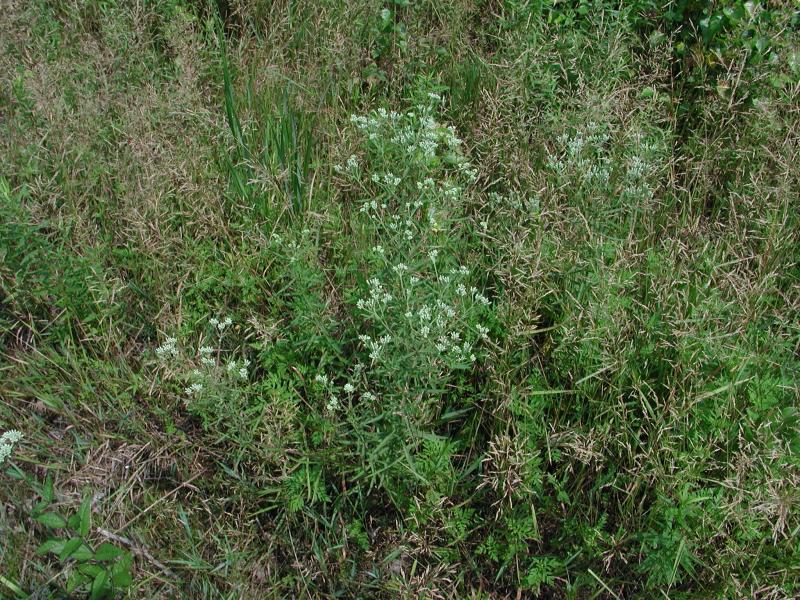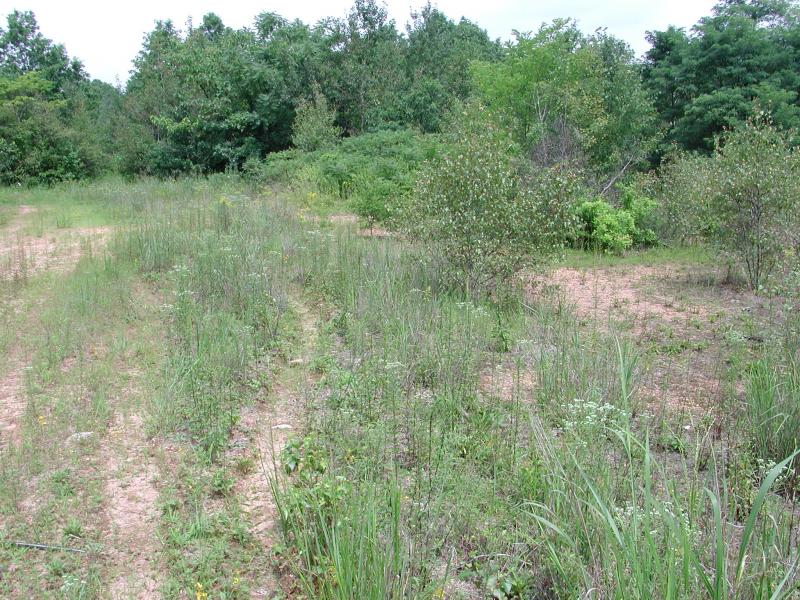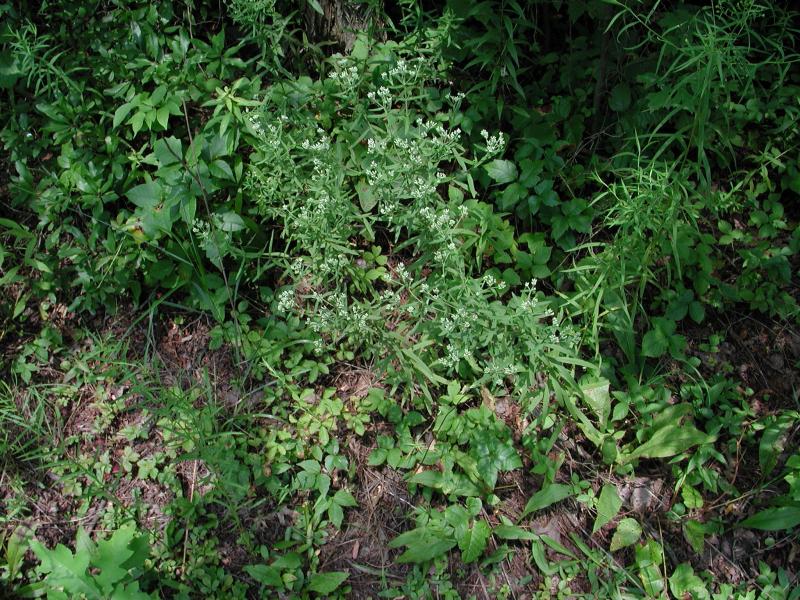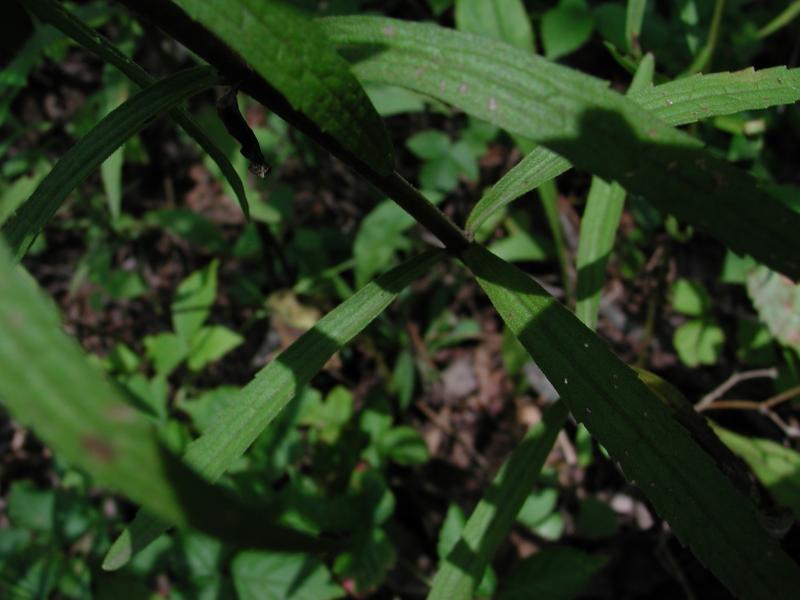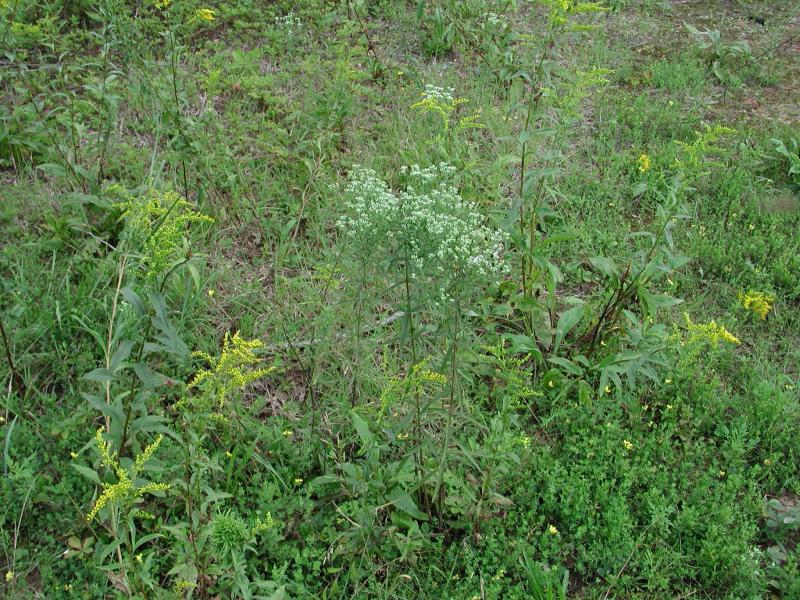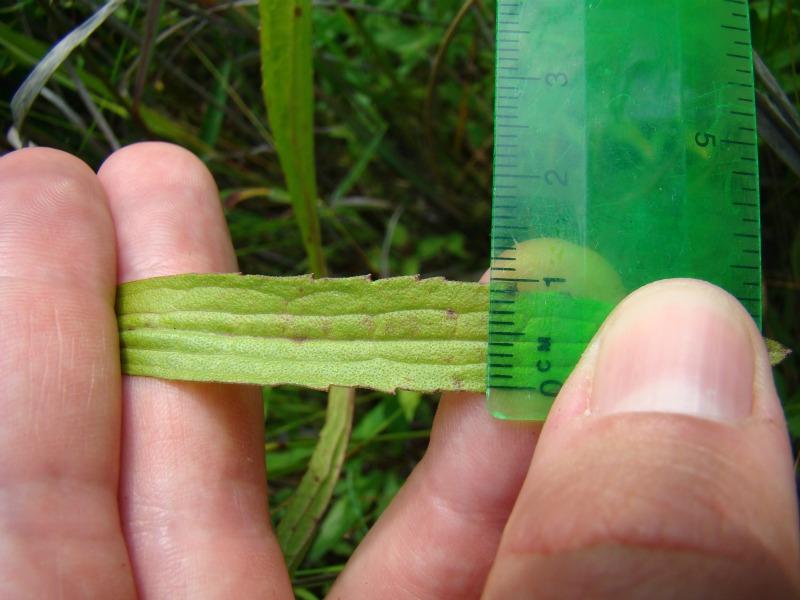Torrey's Thoroughwort
Eupatorium torreyanum Short & Peter
- Class
- Dicotyledoneae (Dicots)
- Family
- Asteraceae (Aster Family)
- State Protection
- Threatened
Listed as Threatened by New York State: likely to become Endangered in the foreseeable future. For animals, taking, importation, transportation, or possession is prohibited, except under license or permit. For plants, removal or damage without the consent of the landowner is prohibited.
- Federal Protection
- Not Listed
- State Conservation Status Rank
- S2
Imperiled in New York - Very vulnerable to disappearing from New York due to rarity or other factors; typically 6 to 20 populations or locations in New York, very few individuals, very restricted range, few remaining acres (or miles of stream), and/or steep declines.
- Global Conservation Status Rank
- G5T4T5
Apparently or Demonstrably Secure globally - The subspecies/variety is uncommon to common in the world, but not rare; usually widespread, but may be rare in some parts of its range; possibly some cause for long-term concern due to declines or other factors. More information is needed to assign either T4 or T5. (The species as a whole is common globally.)
Summary
Did you know?
The genus named Eupatorium honors Mithridates Eupator, a ruler of the region Pontus on the southern edge of the Black Sea, who reportedly used a species of the genus in medicine (Fernald 1970). The species and variety name refer to the leaves which resemble a species of the European hyssop, and have larger and more ragged teeth than the typical variety of this species.
State Ranking Justification
There are 10 existing populations but only three of them are in good to excellent condition. The others are small and may not have good long-term viability. There are four historical occurrences.
Short-term Trends
Current populations seem stable although more survey work needs to be done to evaluate all populations since many have not been resurveyed in recent years.
Long-term Trends
This species doesn't seem to have been very common in New York although populations may have been overlooked because it is not readily identifiable. There are now twice as many current populations as historical populations so the trend seems to be increasing. The common variety of this species is very common and more survey work to distinguish this rare variety may increase the number of occurrences found.
Conservation and Management
Threats
When these plants grow in open areas frequented by people such as trails and beach areas, they may be threatened by trampling or improper maintenance of the trails that could destroy the plants.
Conservation Strategies and Management Practices
Populations need to be protected from direct human impact by vehicles and trampling. Open habitats should be maintained by preventing succession by woody plants.
Research Needs
Research is needed to determine the habitat preference for this species to determine what separates it from where the more common variety grows. This would help improve future surveys and habitat modeling. Other biological differences such as phenology may also be different from the common variety and need to be studied.
Habitat
Habitat
In New York Fringed Boneset has been found in sandy, open habitats, often in grasslands or dunes, but also in openings within shrub thickets or dry oak woods. Some of these sites are adjacent to coastal plain ponds or brackish marshes, and several of the currently known sites are associated with human disturbance such as trails, reservoirs, or airports.
Associated Ecological Communities
- Brackish tidal marsh*
(guide)
A marsh community that occurs where water salinity ranges from 0.5 to 18.0 ppt, and water is less than 2 m (6 ft) deep at high tide. The vegetation in a brackish tidal marsh is dense and dominated by tall grass-like plants.
- Coastal plain pond shore
(guide)
The gently sloping shore of a coastal plain pond with seasonally and annually fluctuating water levels. Plants growing on the pond shore vary with water levels. In dry years when water levels are low there is often a dense growth of annual sedges, grasses, and herbs. Submerged and floating-leaved aquatic plants, such as fragrant waterlily and pondweeds, may become "stranded" on the exposed shore. In wet years when the water level is high only a few emergents and floating-leaved aquatics may be noticeable. T
- Maritime dunes
(guide)
A community dominated by grasses and low shrubs that occurs on active and stabilized dunes along the Atlantic coast. The composition and structure of the vegetation is variable depending on stability of the dunes, amounts of sand deposition and erosion, and distance from the ocean.
- Maritime grassland
(guide)
A grassland community that occurs on rolling outwash plains of the glaciated portion of the Atlantic coastal plain, near the ocean and within the influence of offshore winds and salt spray.
* probable association but not confirmed.
Associated Species
- Baccharis
- Betula populifolia (gray birch)
- Carex silicea (beach sedge)
- Chamaecrista fasciculata
- Chrysopsis mariana (Maryland golden-aster)
- Desmodium marilandicum (smooth small-leaved tick-trefoil)
- Dianthus armeria
- Elaeagnus umbellata (autumn-olive)
- Eupatorium album
- Eupatorium hyssopifolium (hyssop-leaved thoroughwort)
- Eupatorium perfoliatum (boneset)
- Eupatorium pilosum (ragged thoroughwort)
- Euthamia graminifolia (common flat-topped-goldenrod)
- Lathyrus japonicus
- Liquidambar styraciflua (sweet-gum)
- Lobelia nuttallii (Nuttall's lobelia)
- Myrica pensylvanica
- Panicum virgatum (switch grass)
- Phragmites
- Populus deltoides
- Prunus serotina
- Rosa multiflora (multiflora rose)
- Schizachyrium scoparium
- Smilax herbacea (common carrion-flower)
- Smilax rotundifolia (common greenbrier)
- Solidago juncea (early goldenrod)
- Solidago speciosa (showy goldenrod)
- Sorghastrum nutans (Indian grass)
- Spiraea
Range
New York State Distribution
In New York his variety is known only from the Long Island and New York City areas.
Global Distribution
Eupatorium torreyanum reaches its northern limit in New York and southern New England, and ranges west as far as Ohio, and south from Florida to Louisiana.
Identification Comments
General Description
Eupatorium torreyanum is a perennial herb in the aster family, 1.0 to 1.5 m tall. The stems are from short rhizomes or caudices, and are sparsely branched and pubescent throughout. The leaves are mostly opposite or 3-whorled, simple, and sessile, 5-10 mm wide (6-15 times long as wide). They have widely-spaced but conspicuous teeth and are dotted with glands. The principal leaves have fascicles of much-reduced leaves emerging from their axils. The infloresence is of discoid flowers only, arranged into corymbiform (flat or round-topped) heads of five florets each, the corollas are white and 3-3.5 mm, and the calices form pappi of 10-20 bristles 3-3.5mm long.
Best Life Stage for Proper Identification
Flowering or fruiting specimens are best for identification.
Similar Species
The very similar Eupatorium hyssopifolium has mostly linear, narrower (2-5 mm) leaves than those of Eupatorium torreyanum (5-10 mm), with margins that are entire or have only tiny teeth (vs. toothed) and the leaves are usually 4 at a node (vs. usually 2-3). Eupatorium altissimum can grow up to 2 m tall, has opposite, softly hairy (vs. hairless to slightly hairy)leaves that are entire towards the base of the stem but have upward-facing teeth towards the tip and are 5-12 cm long and 8-30 mm wide.
Best Time to See
Fringed boneset flowers from July to September, and fruits from October into November.
- Vegetative
- Flowering
- Fruiting
The time of year you would expect to find Torrey's Thoroughwort vegetative, flowering, and fruiting in New York.
Torrey's Thoroughwort Images
Taxonomy
Torrey's Thoroughwort
Eupatorium torreyanum Short & Peter
- Kingdom Plantae
- Phylum Anthophyta
- Class Dicotyledoneae
(Dicots)
- Order Asterales
- Family Asteraceae (Aster Family)
- Order Asterales
- Class Dicotyledoneae
(Dicots)
- Phylum Anthophyta
Additional Common Names
- Boneset
- Fringed Boneset
- Throughwort
Synonyms
- Eupatorium hyssopifolium var. laciniatum Gray
Comments on the Classification
This species is hybrid-derived and should not be treated as a variety. It is now treated as a full species.
Additional Resources
Best Identification Reference
Gleason, Henry A. and A. Cronquist. 1991. Manual of Vascular Plants of Northeastern United States and Adjacent Canada. The New York Botanical Garden, Bronx, New York. 910 pp.
Other References
Fernald, M.L. 1950. Gray's manual of botany. 8th edition. D. Van Nostrand, New York. 1632 pp.
Flora of North America Editorial Committee. 2006c. Flora of North America North of Mexico. Vol. 21. Magnoliophyta: Asteridae, part 8: Asteraceae, part 3. Oxford Univ. Press, New York. xxii + 616 pp.
Haines, A. 2005. New combination in Eupatorium (Asteraceae). Botanical Notes 11: 1-4.
Holmgren, Noel. 1998. The Illustrated Companion to Gleason and Cronquist's Manual. Illustrations of the Vascular Plants of Northeastern United States and Adjacent Canada. The New York Botanical Garden, Bronx, New York.
New York Natural Heritage Program. 2010. Biotics database. New York Natural Heritage Program. New York State Department of Environmental Conservation. Albany, NY.
New York Natural Heritage Program. 2024. New York Natural Heritage Program Databases. Albany, NY.
Weldy, T. and D. Werier. 2010. New York flora atlas. [S.M. Landry, K.N. Campbell, and L.D. Mabe (original application development), Florida Center for Community Design and Research http://www.fccdr.usf.edu/. University of South Florida http://www.usf.edu/]. New York Flora Association http://newyork.plantatlas.usf.edu/, Albany, New York
Weldy, Troy W. and David Werier. 2005. New York Flora Atlas. [S.M. Landry, K.N. Campbell, and L.D. Mabe (original application development), Florida Center for Community Design and Research. University of South Florida]. New York Flora Association, Albany, NY. Available on the web at (http://newyork.plantatlas.usf.edu/).
Links
About This Guide
Information for this guide was last updated on: January 14, 2019
Please cite this page as:
New York Natural Heritage Program. 2024.
Online Conservation Guide for
Eupatorium torreyanum.
Available from: https://guides.nynhp.org/fringed-boneset/.
Accessed July 27, 2024.
